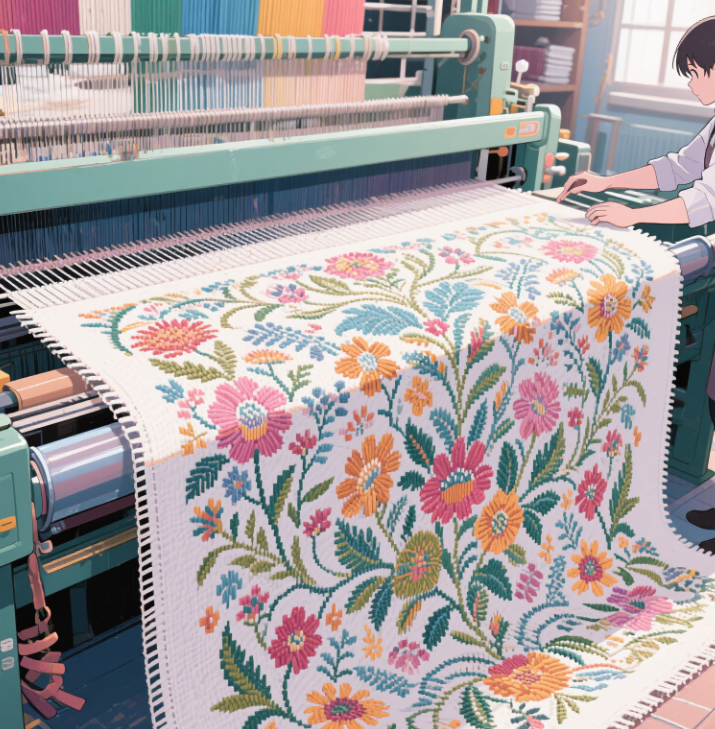1.Jacquard Fabric Redefines Textile Aesthetics with Advanced Pattern Control
1.1 Precision Weaving Enables Intricate Design Possibilities
At the core of Jacquard fabric's appeal lies its highly controlled weaving process, which allows every individual yarn to be manipulated independently. Unlike conventional plain or twill weaves, Jacquard technology empowers designers to integrate complex patterns—floral motifs, geometric structures, or even abstract graphics—directly into the fabric’s construction, not just printed on its surface. This high-resolution weaving unlocks artistic freedom and sets Jacquard apart from standard fabrics.
1.2 Pattern Design Gains Artistic Sophistication and Layered Depth
Jacquard fabric patterns are not flat or repetitive. By adjusting the position, sequence, and color of each yarn, designers can build up visual layers, achieving sophisticated effects of shadow, contrast, and rhythm. The result is a sense of depth and dynamism, allowing the fabric to appear three-dimensional even on a flat surface, and providing a textile canvas that is both visually rich and emotionally expressive.
1.3 Structural Integrity Meets Decorative Innovation
Despite its visual complexity, Jacquard fabric does not sacrifice durability. Its structural integrity, supported by the tight interlacing of high-quality yarns, ensures that artistic patterns do not compromise wear resistance or strength. This fusion of decoration and function is a defining feature of Jacquard textile engineering, catering to both luxury fashion and high-end interior design markets.

2.From Flat to Form: Jacquard Fabric Brings Designs to Life in 3D
2.1 Three-Dimensional Texture Achieved Through Weaving Innovation
Jacquard fabric distinguishes itself by producing not only visual but also tactile depth. By selectively altering the weave structure, patterns can be raised or recessed, generating actual texture and creating a three-dimensional surface. This allows designs such as embossed florals or sculptural motifs to emerge organically from the fabric itself, delivering an experience that goes beyond sight to include touch.
2.2 Visual Movement and Texture through Layered Yarn Interplay
The interplay of yarns with varying thickness, tension, and material composition results in subtle changes in elevation across the fabric surface. This “movement” lends Jacquard textiles a dynamic quality, where light reflection and shadow contribute to a living, changing surface—ideal for applications in fashion, upholstery, and decorative arts that require luxury and sensory richness.
2.3 Fabric Becomes a Canvas for Architectural Design
With its ability to break free from the two-dimensional plane, Jacquard fabric enters the realm of functional art. Designers can incorporate elements of architectural rhythm, topography, or sculpture into their patterns. Whether simulating the curve of a leaf or the geometry of a building facade, Jacquard fabric can faithfully reproduce these structures in thread, enabling textile to become a storytelling medium.

3.Unlimited Design Expression: Color, Creativity, and Cultural Integration
3.1 Multi-Color Yarn Weaving Unlocks Vibrant Visual Effects
Unlike printed fabrics that rely on surface dyes, Jacquard fabrics use pre-colored yarns that are woven into complex designs. This approach enables precise color placement, gradient transitions, and dynamic interweaving effects. The result is a rich chromatic depth that is durable and permanent—perfect for both fashion and interiors where long-lasting vibrancy is key.
3.2 Fusion of Traditional Motifs and Contemporary Art Styles
Jacquard technology allows for immense flexibility in artistic interpretation. Traditional cultural patterns such as damask, brocade, or Eastern floral motifs can be faithfully replicated, while modern abstract compositions, minimalist line art, or digital-inspired designs can also be executed with equal precision. This makes Jacquard a bridge between heritage craftsmanship and contemporary design innovation.
3.3 A Platform for Personalized and Signature Fabric Designs
With the ability to customize every aspect of the weave—yarn type, density, color, and structure—Jacquard fabric serves as a platform for personalized and brand-specific creations. Designers can produce one-of-a-kind patterns tailored to seasonal collections, thematic interiors, or cultural narratives. Each Jacquard fabric becomes more than a material—it becomes an expression of identity and imagination.